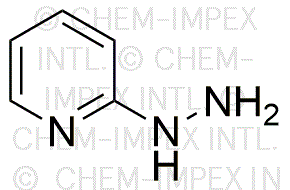2-Hydrazinopyridine is widely utilized in research focused on:
- Pharmaceutical Development: This compound serves as a key intermediate in the synthesis of various pharmaceuticals, particularly in the development of anti-cancer agents.
- Agricultural Chemicals: It is used in the formulation of agrochemicals, enhancing the efficacy of pesticides and herbicides, which helps in improving crop yields.
- Analytical Chemistry: 2-Hydrazinopyridine is employed in analytical methods for detecting and quantifying carbonyl compounds, providing a reliable approach for quality control in food and pharmaceuticals.
- Material Science: The compound is utilized in the development of polymer materials, contributing to improved properties such as thermal stability and mechanical strength.
- Coordination Chemistry: It acts as a ligand in coordination complexes, which are important in catalysis and materials synthesis, offering unique properties compared to other ligands.
General Information
Properties
Safety and Regulations
Applications
2-Hydrazinopyridine is widely utilized in research focused on:
- Pharmaceutical Development: This compound serves as a key intermediate in the synthesis of various pharmaceuticals, particularly in the development of anti-cancer agents.
- Agricultural Chemicals: It is used in the formulation of agrochemicals, enhancing the efficacy of pesticides and herbicides, which helps in improving crop yields.
- Analytical Chemistry: 2-Hydrazinopyridine is employed in analytical methods for detecting and quantifying carbonyl compounds, providing a reliable approach for quality control in food and pharmaceuticals.
- Material Science: The compound is utilized in the development of polymer materials, contributing to improved properties such as thermal stability and mechanical strength.
- Coordination Chemistry: It acts as a ligand in coordination complexes, which are important in catalysis and materials synthesis, offering unique properties compared to other ligands.
Documents
Safety Data Sheets (SDS)
The SDS provides comprehensive safety information on handling, storage, and disposal of the product.
Product Specification (PS)
The PS provides a comprehensive breakdown of the product’s properties, including chemical composition, physical state, purity, and storage requirements. It also details acceptable quality ranges and the product's intended applications.
Certificates of Analysis (COA)
Search for Certificates of Analysis (COA) by entering the products Lot Number. Lot and Batch Numbers can be found on a product’s label following the words ‘Lot’ or ‘Batch’.
*Catalog Number
*Lot Number
Certificates Of Origin (COO)
This COO confirms the country where the product was manufactured, and also details the materials and components used in it and whether it is derived from natural, synthetic, or other specific sources. This certificate may be required for customs, trade, and regulatory compliance.
*Catalog Number
*Lot Number
Safety Data Sheets (SDS)
The SDS provides comprehensive safety information on handling, storage, and disposal of the product.
DownloadProduct Specification (PS)
The PS provides a comprehensive breakdown of the product’s properties, including chemical composition, physical state, purity, and storage requirements. It also details acceptable quality ranges and the product's intended applications.
DownloadCertificates of Analysis (COA)
Search for Certificates of Analysis (COA) by entering the products Lot Number. Lot and Batch Numbers can be found on a product’s label following the words ‘Lot’ or ‘Batch’.
*Catalog Number
*Lot Number
Certificates Of Origin (COO)
This COO confirms the country where the product was manufactured, and also details the materials and components used in it and whether it is derived from natural, synthetic, or other specific sources. This certificate may be required for customs, trade, and regulatory compliance.


